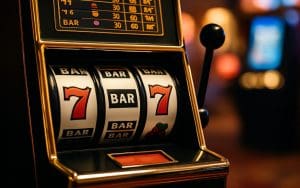Slot machines look like innocent little games of chance—bright colors, fun sounds, push the button, see what happens. But anyone who’s sat in front of one for more than ten minutes knows they each have a “mood.” Some machines hand out small wins so often you feel like you’re on a drip-feed of coins. Others stay quiet for what feels like ages, and then—bam—the kind of payout that makes you double-check your balance twice. That “mood” isn’t random; it’s slot volatility, also called variance.
Think of it as a slot’s personality. Some are chill, some are drama queens, and some are balanced, like that friend who’s calm but still knows how to surprise you.
What Is Slot Volatility?
Volatility in slots is basically the risk profile of a game. It doesn’t just decide if you’ll win but also how often and how much. High volatility is like ordering a mystery box: most of the time you’ll get socks, but every once in a while you pull out something worth bragging about. Low volatility is more like getting small gifts every week—never life-changing, but hey, it keeps you smiling. Medium volatility, as you’d expect, is somewhere in between.
I remember the first time I hit a bonus round in a high-volatility slot. I’d been spinning for nearly half an hour with nothing but tiny crumbs. I was about to walk away, slightly grumpy, and then suddenly the bonus landed. The payout was so big compared to my stake that my whole frustration flipped into laughter. That’s volatility in action.
Why Volatility Matters in Slot Games
You might think all slots are just flashy reels and luck, but volatility shapes your entire session. It decides whether you’re going to feel entertained, stressed, or somewhere in between. Imagine sitting down with twenty bucks. On a low volatility slot, you could stretch that into a decent hour of play with lots of small “yay” moments. On a high volatility slot, you might burn through it in ten minutes… unless you hit that one massive bonus that makes you call your friend just to say, “You won’t believe what just happened.”
So if you care about pacing, mood, and how long your bankroll lasts, volatility matters more than most people realize.
High, Medium, and Low Volatility: Definitions
High volatility slots are the thrill rides. You’ll get long dry stretches, but when they finally decide to be generous, the payouts are the kind that make you screenshot your balance. They can be frustrating, yes, but they’re also unforgettable.
Medium volatility games give you a bit of both: steady play with occasional spikes. Think of them as reliable with a dash of excitement—like a good TV show that occasionally drops a plot twist.
Low volatility slots? They’re cozy. Wins come often, though usually smaller than your bet. It feels like sitting at a café where the waiter keeps refilling your coffee. Nothing shocking, but comforting and steady.
How Volatility Affects Payouts and Gameplay
Volatility works hand in hand with RTP (Return to Player) and hit frequency. A game can have a solid RTP of, say, 96%, but how that plays out depends on volatility. A high-volatility slot could reach that return with rare but huge jackpots. A low-volatility slot gets there by constantly giving you back small amounts.
Gameplay feels different, too. A high-volatility slot builds tension. You might feel like nothing’s happening until suddenly, wilds and scatters start popping in, and your heart rate spikes. A low-volatility slot, meanwhile, is like background music—you can enjoy steady wins while sipping a drink, not constantly on edge.
Example Games for Each Volatility Level
Examples make this easier to picture. Slot providers practically design these categories on purpose, so some titles have become the poster children of volatility.
High Volatility
Book of Dead by Play’n GO is notorious. You might spin for ages with empty reels, but when the free spins line up with premium symbols, it’s electric. Dead or Alive II by NetEnt is another one. It’s the slot equivalent of gambling folklore—you’ll either curse it or tell stories about the night it paid you a month’s rent.
Medium Volatility
Starburst from NetEnt is the “safe” option that still feels lively. Those expanding wilds don’t bring life-changing payouts, but they happen often enough to keep you entertained. Thunderstruck II from Microgaming mixes solid payouts with layered features, like a movie that you can rewatch and still find something fun each time.
Low Volatility
Blood Suckers by NetEnt is famous for treating players kindly. Frequent wins, consistent returns—it’s like that dependable old car that always starts, even if it’s not flashy. Playtech’s Fruity Burst is another one, giving players a steady stream of small wins perfect for long, low-stress sessions.
Should You Play High or Low Volatility Slots?

It depends on your style. Some players are thrill-chasers who love the suspense of waiting for that one big payout. Others just want to stretch their money and enjoy the ride. Neither is wrong.
I once saw two friends play side by side at the same casino. One chose a low volatility fruity slot and happily spun for two hours, getting small wins that covered drinks. The other went for a high volatility jackpot slot, burned through half their budget quickly, and then—out of nowhere—hit a win that made the entire room glance over. Both walked away smiling, but for very different reasons. That’s the personality split volatility creates.
Tips for Choosing Slots Based on Volatility
You don’t always get volatility info spelled out, so you’ve got to play detective. Quick tricks help you figure it out:
- Peek at the paytable. If the top prizes look massive compared to the small ones, odds are it’s high volatility.
- Pay attention to bonuses. Games leaning heavily on free spins with multipliers usually pack more risk.
- Check the bet ranges. Wide ranges often hint at higher volatility potential.
- Test in demo mode. Fifteen minutes of spins will give you a feel for hit frequency.
- Listen to the community. Player forums are full of people debating whether a slot is stingy or friendly.
FAQs About Slot Volatility
What’s the difference between volatility and RTP?
RTP tells you the long-term payback percentage. Volatility tells you how you get there—steady sips or rare gulps.
Can I change a slot’s volatility?
Nope. It’s baked into the design. You can adjust bet size, but the game’s DNA doesn’t change.
Why do high volatility slots feel stingy?
Because they’re designed to. Dry spells are the price you pay for the chance at outsized wins.
Do jackpots always mean high volatility?
Pretty much, yes. Progressive jackpots especially lean toward high variance since the money pools up over time.
Which volatility is best for beginners?
Low volatility, hands down. Frequent wins give you more time to learn without blowing through your bankroll too fast.


